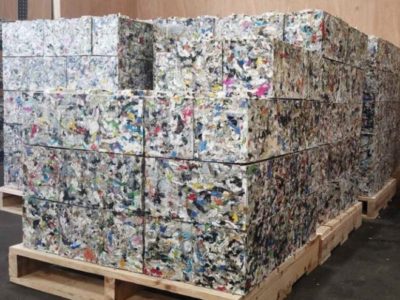The company ByFusion aims to recycle 100 million tons of plastic by 2030, including currently unrecyclable plastics.
They plan to do this using their new patented Blocker system that can consistently convert all types of plastic waste using steam compression into a high-performing, advanced building material called ByBlock® (#1 to #7 plastic, clean or contaminated).
The ByBlock is the size of a standard concrete masonry unit and is a construction-grade building material. It can be used as a substitute for concrete building blocks, with the advantage that they aren’t brittle and therefore don’t crack or crumble. As noted in our previous post about concrete alternatives, cement is a main ingredient of concrete, and each year, more than 4 billion tons of cement are produced, accounting for around 8% of global CO2 emissions.
The ByBlocks have Lego-like protrusions on their tops and cavities in their undersides that allow them to be stacked without glue or adhesives. The ByBlock’s surfaces are flat but not smooth, so drywall, siding, and tile can be applied over it with simple hand tools. The company estimates that ByBlocks installation is 75% faster than concrete or brick and reduces material and labor costs by 50%. In addition, assembly instructions and example projects show that ByBlock construction is efficient and attractive. And they even count for LEED credits.
ByFusion sells Blocker System industrial machinery to recycling facilities and finished prefab structures and furniture to end customers.
Proceeds from the prefab structures and furniture fund the company’s collection of discarded plastics from the oceans. As noted in our previous post about single-use plastics, a report from the World Economic Forum states that if the current trends continue, by 2050, there will be more plastic than fish in the planet’s oceans.
The Blocker industrial system takes materials from recycling facilities sorting lines, shreds them, and superheats them to fuse them into blocks. This process turns unrecyclable and contaminated plastics into building materials for sound walls, retaining walls, terracing, community centers, etc. This provides the recycler with valuable material and reduces the expense and environmental impact of transporting these materials to landfills.









thanks for info
My sincerest thanks for the exceptional information you’ve shared on this website. It has been an invaluable resource, and I’m truly grateful for the time and effort you’ve invested in sharing your expertise. I appreciate the diverse range of topics covered and the depth of knowledge shared. Keep up the fantastic work! See you when the fate meets ID : CMT-BSYLPBC7P2855NQ6P1